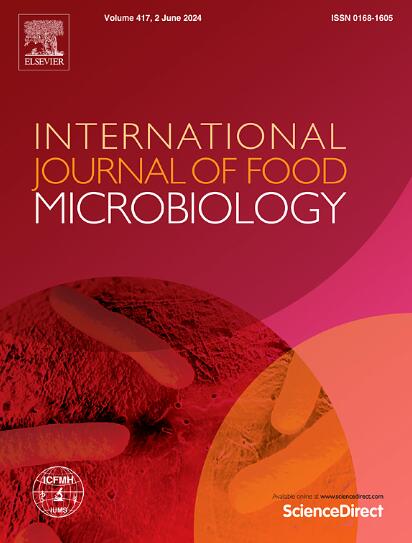Initial acidity regulates microbial sulfur metabolism in the spontaneous fermentation of sesame flavor-type baijiu
IF 5.2
1区 农林科学
Q1 FOOD SCIENCE & TECHNOLOGY
International journal of food microbiology
Pub Date : 2025-03-31
DOI:10.1016/j.ijfoodmicro.2025.111182
引用次数: 0
Abstract
Volatile sulfur compounds play a crucial role in fermented foods, however, their metabolism during spontaneous food fermentation remains underexplored. With 3-(methylthio)-1-propanal as a case, we revealed the effect of initial acidity on the sulfur metabolism during sesame flavor-type baijiu fermentation. Results showed that the content of 3-(methylthio)-1-propanal reached 383.29 μg/kg with 1.8 mmol/10 g of the initial acidity, and it decreased to 320.54 μg/kg when the initial acidity increased to 2.4 mmol/10 g. Metagenomic analysis identified 11 core microbes associated with sulfur metabolism, characterized by gene abundance (> 0.5 %) and catalytic enzyme distribution frequency (> 10 %). Saccharomyces was the main producer of sulfur compounds. Lactobacillus was an important player in the methyl cycle pathway of sulfur metabolism. Low initial acidity increased the abundance of Lactobacillus and the content of genes associated with the methyl cycle pathway (P < 0.05). This resulted in a significant increase of methionine (253.26 mg/kg) (P < 0.05) and 3-(methylthio)-1-propanal contents (383.29 μg/kg) (P < 0.05). In simulated fermentation, the content of 3-(methylthio)-1-propanal significantly increased by 2.91 folds when Saccharomyces cerevisiae was cocultured with Lactobacillus acetotolerans (P < 0.05), and the transcription of genes related to sulfur metabolism significantly increased by 33.71 folds (P < 0.05). Results indicated that low initial acidity increased the abundance of Lactobacillus, which mediates the methyl cycle pathway in the sulfur metabolism, thereby increasing the contents of methionine and volatile sulfur compounds. This work provided insight into the regulation of metabolic mechanisms of volatile sulfur compounds in baijiu fermentation.
初始酸度对芝麻风味白酒自发发酵过程中微生物硫代谢的调节作用
挥发性硫化合物在发酵食品中起着至关重要的作用,然而,它们在自发食物发酵过程中的代谢仍未得到充分的研究。以3-(甲基硫)-1-丙醇为例,研究了初始酸度对芝麻香型白酒发酵过程中硫代谢的影响。结果表明,当初始酸度为1.8 mmol/10 g时,3-(甲基硫)-1-丙醛含量达到383.29 μg/kg,当初始酸度增加到2.4 mmol/10 g时,3-(甲基硫)-1-丙醛含量降至320.54 μg/kg。宏基因组分析鉴定出11种与硫代谢相关的核心微生物,其特征是基因丰度(>;0.5%)和催化酶分布频率(>;10%)。酵母菌是含硫化合物的主要生产者。乳酸菌是硫代谢甲基循环途径的重要参与者。较低的初始酸度增加了乳酸菌的丰度和甲基循环途径相关基因的含量(P <;0.05)。这导致蛋氨酸显著增加(253.26 mg/kg)。0.05)和3-(甲基硫)-1-丙醛含量(383.29 μg/kg) (P <;0.05)。在模拟发酵中,酿酒酵母与醋酸耐受乳杆菌(P <;0.05),硫代谢相关基因的转录量显著增加了33.71倍(P <;0.05)。结果表明,较低的初始酸度增加了介导硫代谢甲基循环途径的乳酸菌的丰度,从而增加了蛋氨酸和挥发性硫化合物的含量。本研究为白酒发酵过程中挥发性硫化合物的代谢调控机制提供了新的思路。
本文章由计算机程序翻译,如有差异,请以英文原文为准。
求助全文
约1分钟内获得全文
求助全文
来源期刊
CiteScore
10.40
自引率
5.60%
发文量
322
审稿时长
65 days
期刊介绍:
The International Journal of Food Microbiology publishes papers dealing with all aspects of food microbiology. Articles must present information that is novel, has high impact and interest, and is of high scientific quality. They should provide scientific or technological advancement in the specific field of interest of the journal and enhance its strong international reputation. Preliminary or confirmatory results as well as contributions not strictly related to food microbiology will not be considered for publication.

 求助内容:
求助内容: 应助结果提醒方式:
应助结果提醒方式:


